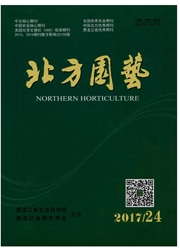

 中文摘要:
中文摘要:
以4个耐热性存在差异的菜心品种(系)为试材,研究持续高温胁迫对菜心叶片中渗透调节物质、电解质渗漏率、活性氧的产生与清除的影响。结果表明:短期(1d)高温胁迫下,除过氧化氢酶(CAT)酶活性在耐热性弱的菜心材料中急剧增加,且达到活力最高值外,其它性状如脯氨酸和甜菜碱含量、电解质渗漏率、丙二醛(MDA)含量、O产生速率、H2O2含量、超氧化物歧化酶(SOD)和过氧化物酶(POD)酶活性出现小幅度增加,且这些性状的值在4个菜心材料间差异不大;随着高温胁迫处理时间的延长(3~7d),生理指标在4个材料中呈现不同程度的增加,表现出耐热性强的材料的甜菜碱含量、SOD、POD和CAT酶活性均明显高于耐热性弱的材料,电解质渗漏率、MDA含量、OT产生速率、H2O2含量则明显低于耐热性弱的材料;而脯氨酸含量的高低则未表现出与菜心耐热性强弱的对应关系。
 英文摘要:
英文摘要:
Four flowering chinese cabbage were selected as material, electrolytic leakage rate and the production and scavenging of active oxygen in the leaves of heat-tolerant and heat-sensitive genotypes of flowering Chinese cabbage under heat stress were studied. The results showed that most of traits including the contents of proline and betaine, electrolytic leakage rate, malondialdehyde (MDA) content, 07- producing rate, H2O2 content, activities of superoxide disrnutase (SOD) and peroxidase (POD) increased slightly and were not significant differences under the short (1 d) period of heat stress in four genotypes of flowering Chinese cabbage, except catalase (CAT) which its activity rapidly increased and reached the peak in two heat-sensitive genotypes under 1 d of heat stress. The values of these physiological traits continuously increased with different degree in four genotypes with stress time (347 d), and showed that the betaine content, the activities of SOD, POD and CAT in heat-tolerant genotypes were significant higher than that in heatsensitive genotypes, electrolytic leakage rate, MDA content, O2 producing rate and H2O2 content were significant lower than that in sensitive genotypes, while proline accumulation was not related to heat tolerance or heat sensitive in flowering Chinese cabbage under heat stress condition.
 同期刊论文项目
同期刊论文项目
 同项目期刊论文
同项目期刊论文
 期刊信息
期刊信息
